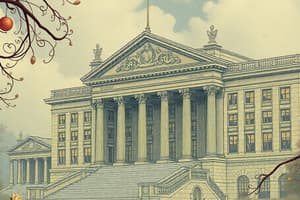Podcast
Questions and Answers
Which of the following is a way for governments to change the money supply?
Which of the following is a way for governments to change the money supply?
- Open market operations
- Reserve requirement
- Discount rate
- All of the above (correct)
Securitization is a way for financial institutions to eliminate the risk of financial panic.
Securitization is a way for financial institutions to eliminate the risk of financial panic.
False (B)
What is the simple money deposit ratio if the required reserve ratio is 9.0%?
What is the simple money deposit ratio if the required reserve ratio is 9.0%?
11.11
Increasing the reserve ratio will _____ the money multiplier.
Increasing the reserve ratio will _____ the money multiplier.
If the central bank has increased the money supply such that there are an additional $43,819 in excess reserves with a reserve ratio of 13 percent, what is the maximum the money supply could increase?
If the central bank has increased the money supply such that there are an additional $43,819 in excess reserves with a reserve ratio of 13 percent, what is the maximum the money supply could increase?
Bank runs are beneficial for the bank affected.
Bank runs are beneficial for the bank affected.
S&Ls are not covered by federal deposit insurance.
S&Ls are not covered by federal deposit insurance.
If your deposit increases the total value of checkable bank deposits with a reserve requirement of 18%, how much will it increase?
If your deposit increases the total value of checkable bank deposits with a reserve requirement of 18%, how much will it increase?
If Storgan Manley increases its profitability by borrowing money to invest, what is this process called?
If Storgan Manley increases its profitability by borrowing money to invest, what is this process called?
What happens when some of Storgan Manley's assets lose value as other financial institutions experience difficulty?
What happens when some of Storgan Manley's assets lose value as other financial institutions experience difficulty?
If a homeowner is unable to make mortgage payments, they can always pay off the mortgage by selling their home.
If a homeowner is unable to make mortgage payments, they can always pay off the mortgage by selling their home.
What are open market operations (OMOs)?
What are open market operations (OMOs)?
A decrease in real GDP causes a ________ the money demand curve.
A decrease in real GDP causes a ________ the money demand curve.
An increase in technology makes it easier to pay for goods and services without carrying cash and causes a _______ the money demand curve.
An increase in technology makes it easier to pay for goods and services without carrying cash and causes a _______ the money demand curve.
A decrease in interest rates causes a ______ the money demand curve.
A decrease in interest rates causes a ______ the money demand curve.
An increase in the aggregate price level causes a ______ the money demand curve.
An increase in the aggregate price level causes a ______ the money demand curve.
What happens in the short-run if the central bank increases the money supply?
What happens in the short-run if the central bank increases the money supply?
How can the Federal Reserve target a higher interest rate?
How can the Federal Reserve target a higher interest rate?
The MD curve will shift to the right if...
The MD curve will shift to the right if...
The MD curve will shift to the left if...
The MD curve will shift to the left if...
What happens when the government reduces the money supply in response to inflation?
What happens when the government reduces the money supply in response to inflation?
How does an increase in money supply affect the AD curve in the short run?
How does an increase in money supply affect the AD curve in the short run?
What does the term 'inflation targeting' refer to?
What does the term 'inflation targeting' refer to?
What does the term 'money neutrality' mean?
What does the term 'money neutrality' mean?
If money is neutral, what does this imply about the use of monetary policy?
If money is neutral, what does this imply about the use of monetary policy?
Why might the central bank engage in contractionary monetary policy when potential GDP increases?
Why might the central bank engage in contractionary monetary policy when potential GDP increases?
What causes the AD curve to shift to the right?
What causes the AD curve to shift to the right?
Which of the following causes the AD curve to shift to the left?
Which of the following causes the AD curve to shift to the left?
Which graph accurately reflects demand and supply in the money market?
Which graph accurately reflects demand and supply in the money market?
If two short-term assets offer different interest rates, then investors will move their wealth towards the asset with the lower return.
If two short-term assets offer different interest rates, then investors will move their wealth towards the asset with the lower return.
There is no practical difference between long-term interest rates and short-term interest rates.
There is no practical difference between long-term interest rates and short-term interest rates.
Money demand is affected by short-term interest rates and long-term interest rates.
Money demand is affected by short-term interest rates and long-term interest rates.
Interest rates on financial assets that mature in ten months or less are considered long-term interest rates.
Interest rates on financial assets that mature in ten months or less are considered long-term interest rates.
The opportunity cost of holding money falls when short-term interest rates fall.
The opportunity cost of holding money falls when short-term interest rates fall.
What happens to the equilibrium interest rate if the Federal Reserve decreases the money supply?
What happens to the equilibrium interest rate if the Federal Reserve decreases the money supply?
What are the implications for short-term financial assets when the Federal Reserve decreases the money supply?
What are the implications for short-term financial assets when the Federal Reserve decreases the money supply?
What happens to SRAS and AD in the long run when there is an increase in the money supply?
What happens to SRAS and AD in the long run when there is an increase in the money supply?
Flashcards are hidden until you start studying
Study Notes
Money Supply Management
- Governments can increase or decrease the money supply via open market operations, reserve requirements, and changes in the discount rate.
- Open market operations involve a central bank buying existing bonds to increase money supply.
- Increasing the reserve requirement limits the amount banks can lend, thereby decreasing the money supply.
- Raising the discount rate increases borrowing costs for commercial banks, which can discourage lending.
Securitization
- Securitization is viewed as a method for financial institutions to mitigate risk, but it does not completely eliminate the possibility of financial panic.
Reserve Requirements and Money Multiplier
- A required reserve ratio of 9% results in a simple money deposit ratio of approximately 11.11.
- Increasing the reserve ratio will reduce the money multiplier.
Banking System and Excess Reserves
- If the reserve ratio is 13%, the addition of $43,819 in excess reserves could lead to a maximum increase of $337,069 in the money supply.
Bank Runs
- Bank runs negatively impact the affected banks and do not provide benefits to competitors.
Savings and Loans Institutions
- Savings and Loans (S&L) institutions are covered by federal deposit insurance; any assertion to the contrary is incorrect.
Effects of Deposits on Checkable Bank Deposits
- A deposit of $4,000 with an 18% reserve requirement increases total checkable bank deposits by approximately $22,222.
- With a reserve requirement of 7%, the total increase in checkable deposits would differ.
Leverage in Banking
- Storgan Manley, a large financial institution, utilizes leverage by borrowing to invest, enhancing its profitability.
Financial Crisis of 2008
- The interconnectedness of financial institutions can lead to pervasive financial difficulties, as seen during the 2008 crisis through the balance sheet effect.
Subprime Lending
- Statements regarding subprime lending can be misleading; homeowners may not always sell their homes to cover mortgage payments if they default.
Open Market Operations
- The Federal Reserve can increase money supply by purchasing government securities, which fuels banking reserves and subsequently deposit expansion.
Money Demand Shifts
- A decrease in real GDP leads to a leftward shift in the money demand curve.
- Improvements in payment technology can also result in a leftward shift of the money demand curve.
- A decrease in interest rates causes movement along the money demand curve; increasing aggregate price levels shifts the curve to the right.
Short-Run and Long-Run Effects of Monetary Changes
- An increase in the money supply shifts the money supply curve to the right, resulting in a rise in aggregate price levels.
- The Federal Reserve can target higher interest rates by reducing the money supply through open market operations.
- A reduction in the money supply shifts both the money supply and demand curves leftward, with short-run equilibrium impacted while the long-run equilibrium interest rate may remain unchanged.
Aggregate Demand and Supply Dynamics
- Increases in the money supply shift the aggregate demand curve to the right, impacting interest rates and real GDP positively.
- Conversely, a leftward shift of the aggregate demand curve can occur due to measures like selling bonds or increasing reserve requirements.
Inflation Targeting and Money Neutrality
- Inflation targeting is defined as central banks aiming for specific inflation rates.
- Money neutrality suggests that changes in the money supply have no long-term real effects on the economy, implying that monetary policy is more effective in the short term.
Economic Adjustments and Interest Rates
- Fluctuations in interest rates impact the demand for financial assets, with a risk of decreases in demand for short-term financial products when interest rates rise.
- An increase in money supply leads to short-run adjustments in aggregate supply and demand dynamics, influencing overall price levels and GDP.
Graph Analysis and Economic Implications
- Visual manipulation of money market graphs illustrates the effects of monetary policy changes on supply, demand, and interest rates.
- Long-run effects of changes in money supply show little effect on real GDP while influencing aggregate price levels, emphasizing the complex relationships in economic modeling.
Studying That Suits You
Use AI to generate personalized quizzes and flashcards to suit your learning preferences.




